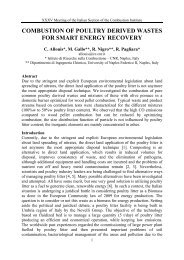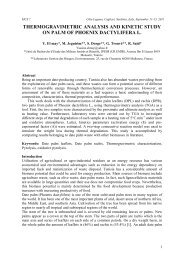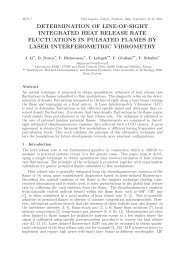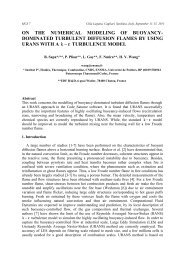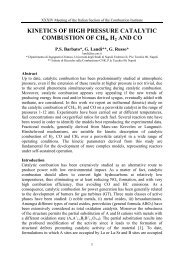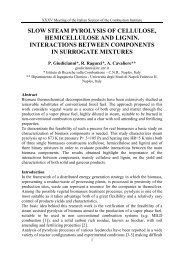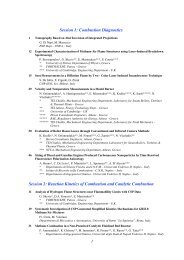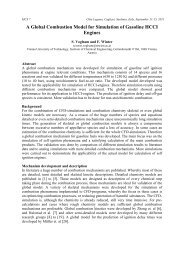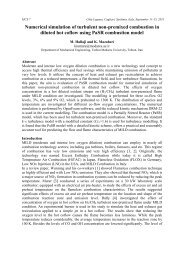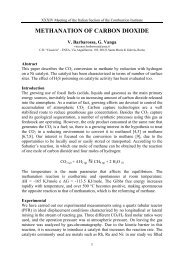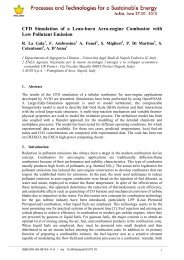SHORT CONTACT TIME CATALYTIC PARTIAL OXIDATION OF CH4 ...
SHORT CONTACT TIME CATALYTIC PARTIAL OXIDATION OF CH4 ...
SHORT CONTACT TIME CATALYTIC PARTIAL OXIDATION OF CH4 ...
You also want an ePaper? Increase the reach of your titles
YUMPU automatically turns print PDFs into web optimized ePapers that Google loves.
XXXV Meeting of the Italian Section of the Combustion Institute<br />
conversions for their outstanding gas-to-solid heat- and mass-transfer<br />
characteristics and high specific geometric surface areas.<br />
Metallic foams are generally used as support structures for high-surface-area<br />
ceramic supports [4,5] such as γ-Al 2 O 3 which are used to disperse the active metal<br />
phase. However the deposition of a thin uniform washcoat layer of refractory<br />
oxides firmly anchored to the metal struts is not a trivial matter, but is of<br />
paramount importance in order to guarantee long catalyst durability. On the other<br />
hand metallic foam/gauze itself can be made of an active catalytic element as for<br />
the case of copper, nickel and their alloys as well as noble metals.<br />
In the present paper, we set out to investigate for the first time the catalytic partial<br />
oxidation of methane - hydrogen mixtures with air over metallic Ni foam catalysts<br />
intended as the first conversion stage in radiant hybrid catalytic burners and<br />
operated under self-sustained high temperature, short contact time conditions.<br />
Experimental<br />
Ni, Pt-Ni and Rh-Ni catalysts were produced using as substrates Ni foam discs<br />
(with a 18 mm diameter) cut from grade 50 INC<strong>OF</strong>OAM TM sheets 0.17 cm thick.<br />
The apparent density of the foam was 0.22 g cm -3 , corresponding to a void volume<br />
fraction of 0.975, an average pore size of ca. 500 μm and strut diameter of ca. 60<br />
μm. The preparation of modified catalysts, was performed via the spontaneous<br />
deposition of noble metals (Pt or Rh) onto those Ni foam substrates, obtained<br />
through the direct immersion of the foam in a solution of complex noble metal ions<br />
(PtCl 6 2- or RhCl 6 3- ) at controlled time and pH. The noble metal loadings in Pt-Ni<br />
and Rh-Ni catalysts employed for the CPO tests were respectively 0.68 % and 0.26<br />
% w./w.<br />
Catalytic Partial Oxidation tests were performed with two identical catalytic discs<br />
(d=18mm, total length 1.7 × 2 = 3.4mm), stacked between two mullite foam<br />
monoliths (45 ppi, L=12mm) as heat shields, and fitted with ceramic paper in a<br />
quartz tube reactor (I.D.= 20mm) which was inserted in an electric furnace. Highpurity<br />
gases (CH 4 , O 2 , N 2 , H 2 ) calibrated via mass-flow controllers, were premixed<br />
and fed to the reactor at a gas hourly space velocity (GHSV) comprised<br />
between 1.1 to 3.4 ×10 5 h -1 corresponding to a minimum contact time (based on the<br />
solid volume of the foam) of 0.27 ms at standard conditions. Catalytic partial<br />
oxidation tests were run under self-sustained high temperature conditions at fixed<br />
preheating (200°C) and an overall pressure of P=1.1 bar, using simulated air as the<br />
oxidant. In view of the partial substitution of methane with hydrogen in a hybrid<br />
combustion device, CPO tests with CH 4 -H 2 mixtures with variable H 2 contents<br />
(yH 2 up to 70% vol. of the fuel) were run at fixed nominal power and equivalence<br />
ratio of the feed (φ = 3.2, 3.6, 4.0 always above the upper flammability limit for the<br />
fuel mix in air at room conditions).<br />
2



